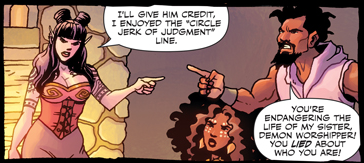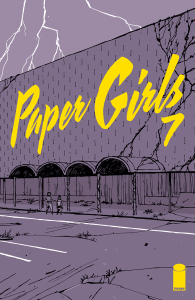 Paper Girls #7
Paper Girls #7
Written by Brian K. Vaughan
Art and Cover by Cliff Chiang
Colors by Matt Wilson
Letters and Design by Jared K. Fletcher
Published by Image Comics on July 6, 2016
So I’m going to drop the gambit of these posts being reviews. Let’s just assume I’m giving this second issue of the new arc 11 stars and move along. I know some reviewers fell out of love with Paper Girls as the first five issues progressed. I have not. The power trio of Brian K. Vaughan, Cliff Chiang, and Matt Wilson continue to enthrall me. Paper Girls’ new arc keeps the intensity going, introduces a new era, and offers great surprises. If you liked the first volume, you should definitely pick up the new issues.
Instead of reviewing, this will be more of an unpacking of the issue. I’ll take a look at the references, reveals, connotations, and symbols and attempt to make some meaning. From here on, consider yourself in SPOILER TERRITORY.

Paper Girls #7 continues to muck about with the perception of 2016 to our three paper girls from 1988: is it a fantastic new world with amazing technology or a near dystopia of broken people and abandoned touch stones? Tiffany is celebratory that the world is even still here considering the wars and other apocalyptic news she’s used to seeing top of the fold. (By the way, the word “fold” ties together that time travel with the newspaper. Just saying.) Mac is down on the future, keeping to her cynical view. The reveal at issue’s end regarding what’s become of her in 2016 pretty much validates her attitude anachronistically. Erin, who is now looking into the life of her future self, sees a mixed bag. On the one hand, her future self never got married (pro!), but on the other, she takes drugs for anxiety (con!). If Vaughan and Chang’s 1988 was depicted with the nostalgic glow of dawn, the team gives 2016 the Sutro Instagram filter, creating a through-a-glass-darkly effect.
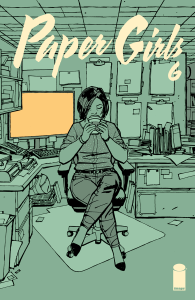 Chiang’s covers for the last two issues have brilliantly highlighted major themes of the new arc. For #6, he depicts the entrapment of routine with 40-year old Erin in a Matrix-y gray-green cubicle office, surrounded by repeated squares of screen, clipboards, sticky notes, binders and drawers, visually echoing Tiffany’s Editrix vision of playing Arkanoid and figuratively boxing Erin in.
Chiang’s covers for the last two issues have brilliantly highlighted major themes of the new arc. For #6, he depicts the entrapment of routine with 40-year old Erin in a Matrix-y gray-green cubicle office, surrounded by repeated squares of screen, clipboards, sticky notes, binders and drawers, visually echoing Tiffany’s Editrix vision of playing Arkanoid and figuratively boxing Erin in.
The cover for #7 trades the green for an ominous dusky purple and the boxes for jagged cracks, repeated in the time travel lightning, the creeping weeds on the sides of the dead mall, and the cracks in the pavement of its parking lot. Dwarfed by these jagged lines are 1988 Erin and 2016 Erin. (Chrononaut Erin has not yet arrived to meet her fellow selves.) We usually see time as a straight line forward, propelled by the passing of minutes and the endless chain of cause and effect. But with time travel in the mix, timelines multiply off of each other like lightning, breaking into the potential futures.
1988 Erin mentions to 2016 Erin that she thinks this timeline is wrong and that she needs to go back to correct it, like in The Terminator. The reference is particularly interesting considering the multiple sequels and reboots the franchise has had since 1984. While 2016 Erin states that it’s just a weird time for her, not post-apocalypse, the presence of Chrononaut Erin suggests that there is in fact work to be done to save the future. Her comfort with the technology and her ability to manipulate the Uber driver in the face of Godzilla-sized water bears suggests that this time traveling is now a thing she does. And she does it well. Who knows how many fractures of the time line have been created. Clearly at least three.
 In the meantime, 1988 Erin is sizing up her elder self, judging her drug use (prescription!) as indication of mental illness. 2016 Erin anticipates her younger self’s judgement and is emotionally relieved when the younger verbally validates aspects of the elder’s life. It is an existential question made concrete: Have you lived the life you wanted to as a child? Erin’s answer is a qualified “kinda.” 1988 Erin’s approval of the elder’s hair, shirt, and choice to remain untethered by marriage elicits a surprise hug, and the panel that follows, where the two strike the same embarrassed pose, is a highlight of the issue. Later, Tiffany and Mac set off to find their 2016 selves, and each of them are scared to see what they’ll be like. Mac’s house is closer, so they go there first, only to find that Mac died in 1992 of leukemia. Mac’s response is one of shocked detachment. She says they’ll be sure to update the subscription information, which offers an ironic understatement to strongly evoke emotional response from the reader.
In the meantime, 1988 Erin is sizing up her elder self, judging her drug use (prescription!) as indication of mental illness. 2016 Erin anticipates her younger self’s judgement and is emotionally relieved when the younger verbally validates aspects of the elder’s life. It is an existential question made concrete: Have you lived the life you wanted to as a child? Erin’s answer is a qualified “kinda.” 1988 Erin’s approval of the elder’s hair, shirt, and choice to remain untethered by marriage elicits a surprise hug, and the panel that follows, where the two strike the same embarrassed pose, is a highlight of the issue. Later, Tiffany and Mac set off to find their 2016 selves, and each of them are scared to see what they’ll be like. Mac’s house is closer, so they go there first, only to find that Mac died in 1992 of leukemia. Mac’s response is one of shocked detachment. She says they’ll be sure to update the subscription information, which offers an ironic understatement to strongly evoke emotional response from the reader.
 Vaughan gives a bit of symbolism in the form of the gigantic water bears. Chrononaut Erin mentions that size is relative, like time, and so as objects approach the time fold’s event horizon, they grow incredibly large. Erin brought an otherwise microscopic entity with her through the fold, but its size didn’t adjust back after the jump. Perhaps she wears tech that helps her size down again. Sidenote: water bears are officially known as tardigrades, which evokes Tardis. These tardigrades are now bigger on the outside. I also suspect that this particular microscopic organism was chosen for it’s visual similarity to the Cronenbergian Tardis that Heck and Naldo traveled in.
Vaughan gives a bit of symbolism in the form of the gigantic water bears. Chrononaut Erin mentions that size is relative, like time, and so as objects approach the time fold’s event horizon, they grow incredibly large. Erin brought an otherwise microscopic entity with her through the fold, but its size didn’t adjust back after the jump. Perhaps she wears tech that helps her size down again. Sidenote: water bears are officially known as tardigrades, which evokes Tardis. These tardigrades are now bigger on the outside. I also suspect that this particular microscopic organism was chosen for it’s visual similarity to the Cronenbergian Tardis that Heck and Naldo traveled in.
As for the symbolism, the theme that gets highlighted by the supersized tardigrade is the powerful effect of small things on an infinite timeline. The butterfly effect, you know? A little stowaway on Erin’s time travel boat becomes an epic monster and danger to humanity. In this way, Vaughan takes a semi-humorous oddity–water bear Godzillas–and ties it to the comic’s meaning. He’s been doing this from the beginning, making the details work to connote explanations for the story’s mysteries.
If you came for the translation of the chrononaut language, I shall not disappoint. The translations are after the decoder key below.
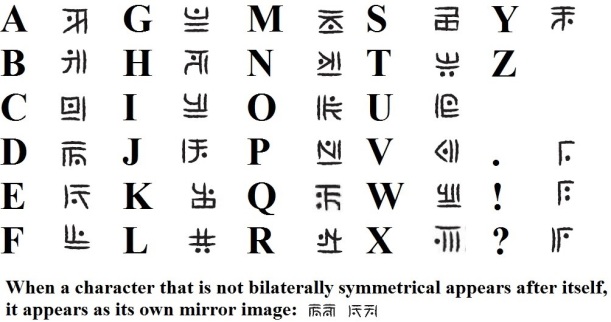
- HEY!
- DONT DO THAT!
- HOLD ON WOULD YOU KEEP SAYING STUFF PLEASE?
I continue to be pleased that the translation isn’t necessary but always adds flavor to the scenes it’s featured in.
Four new songs added to the Paper Girls Spotify Playlist:
- “There Will Still Be Time” by Mumford and Sons
- “Comfortably Numb” by Dar Williams and Ani DiFranco
- “I Thought the Future Would be Cooler” by YACHT
- “The Terminator Theme” by Brad Fiedel







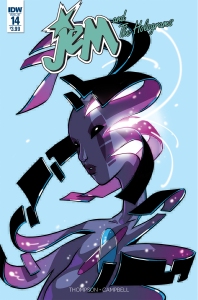 Jem and the Holograms #14
Jem and the Holograms #14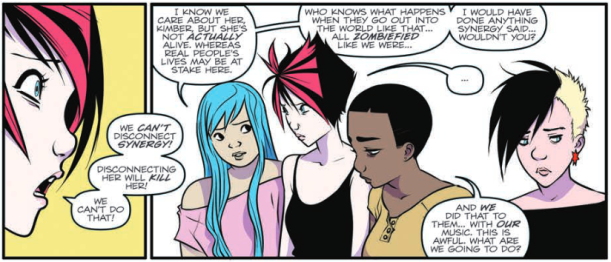




 In this Cell by Cell, I look deeply into the panels of Bitch Planet #6, pages 11-12, appreciating and analyzing the story and artistic composition.
In this Cell by Cell, I look deeply into the panels of Bitch Planet #6, pages 11-12, appreciating and analyzing the story and artistic composition.

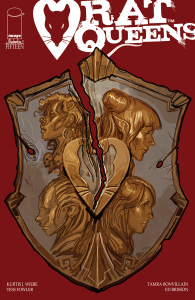 Rat Queens #15
Rat Queens #15